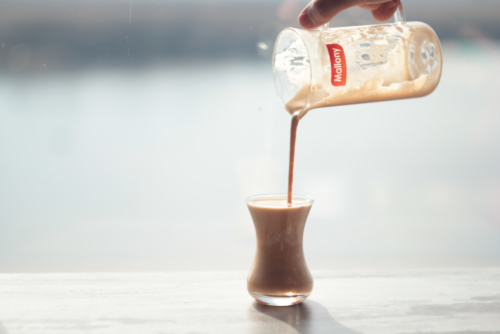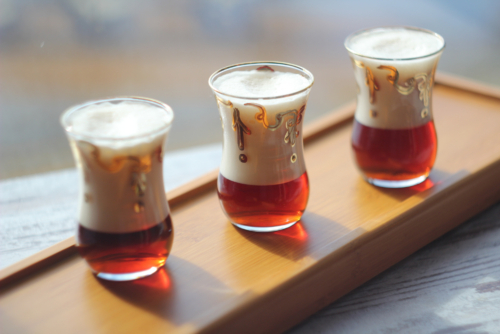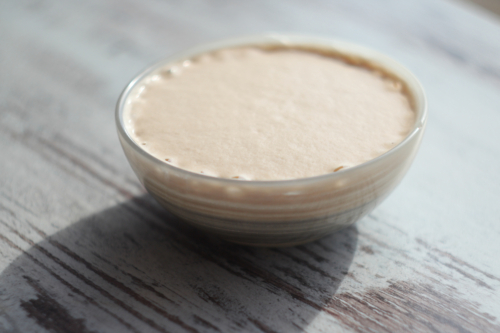Tea is known to contain substances with surface-active properties. Which adds bubbles in the cup to the other advantages of the drink. The content of such substances in tea is small, therefore, under normal conditions, bubbles in tea are a noticeable, but short-term and unremarkable phenomenon. However, in unusual conditions, these substances can show their surfactant properties in all their glory and ensure that the tea produces sufficiently dense and stable froth with a pure tea taste and aroma.

I am talking neither about nitro tea nor about beating tea powder in the Japanese ceremonial style. It’s about simple and pure frothing of tea infusion — about the same as with the traditional consumption of Batabatacha — one of the rare and peculiar kinds of Japanese post-fermented teas.
In order to prepare and serve tea with froth, you need a small French press (300-330 ml), strong tea brewed in a separate vessel (about six teaspoons per 500 ml of water, but this is variable) and glassware for serving the finished drink. I like serving frothed tea in a traditional Turkish bardak (preferably, without a pattern), but other glassware can be used as well — “glass” type (long and narrow)or “wide bowls” type, doesn’t matter. From the latter, it is very cool not even to drink the froth, but to eat it, with a spoon, for example. And the froth behaves a little differently in them.
Strain the strong tea infusion, pour it into the French press so that it is a couple of centimeters above the piston in its lowest position. Beat it with quick and graceful movements, while firmly holding the French press itself and fixing its lid so as not to rip it off in the heat of the moment.
Strong tea is whipped into froth very quickly, literally in 10-20 seconds — after which the whipped tea must be poured into a glass, where it immediately begins to settle, turning into a chic layered drink. The tea froth is quite dense and persistent — you can put various toppings on it and sometimes it can last for dozens of minutes. After some experiments with whipping tea, I came to the conclusion that light teas (green and white) give a more persistent froth than dark ones — but I won’t insist, there is still not enough data.
In short, frothed tea is a technically very simple, cheap and effective technique. Of course, it is impossible to make a full-fledged format of serving tea out of it or build a tea menu on its basis, but as an additional competence in the treasury of a tea specialist who “has one more trick up his sleeve”, it works just fine. Especially at various festive tea sessions.
You can also use a whisk or cappuccino maker to froth over-brewed tea — although I like the French press more. Naturally, the flavor of frothed tea depends on standard tea factors. On the tea itself, on the ratio of the amount of tea leaves to the volume of water, on the temperature of the water (you can froth cold brew too) and on the duration of infusion. But there are some specific nuances in serving frothed tea.
To begin with, frothed tea is effective, but too strong. Its froth is tasty and aromatic, but the infusion itself is not very tasty and too caffeinated. You can solve this problem by separately brewing one tea for drinking and one for frothing. In two different teapots. Tea brewed in the usual way is poured into a glass, and tea froth is set on top of it — this is technically more difficult, but tastier. Plus, you increase the rate of tea leaves consumption this way.
The froth from dark teas, especially from shu pu-erh tea, forms two color layers upon settling and the drink as a whole becomes visually three-layer (tea, dark froth, light froth). Taking into account the fact that frothed tea behaves very dynamically in a glass, the serving is very beautiful.
As I said earlier, tea froth will withstand a variety of toppings. You can put on top of it blackcurrant powder, a few lavender pieces or a little ground cinnamon. But the coolest thing, of course, is to sprinkle some tea powder on the froth. You can get very meticulous: brew a portion of ‘normal’ tea, then brew the same kind of tea strongly and grind a small portion of the same dry tea leaves into powder. Then serve the ‘normal’ tea in a glass under a cap of froth made from the strong tea and top it with the powder of the same tea. You get one pure tea in one glass, but served in a very tricky way.
And the most wonderful thing: the froth makes a noise when settling. This noise is heard distinctly. So, frothed tea can not only be viewed, smelled, tasted and touched. You can also listen to it — and perceive one cup of tea with all five senses… It’s very funny and very touching, sitting at the tea table with your ear pressed against a glass of tea… Enjoy your tea! And do not spare tea leaves.
Olga Nikandrova & Denis Shumakov. Teatips.info. 2021








